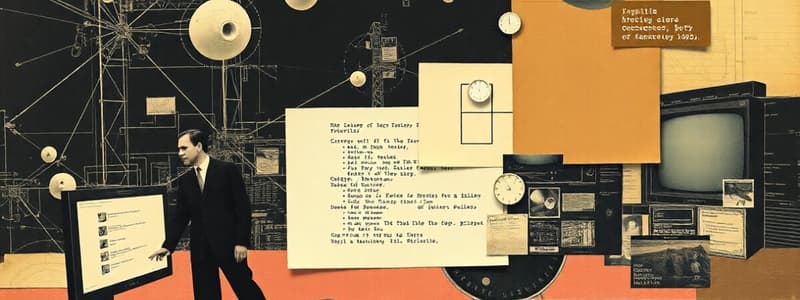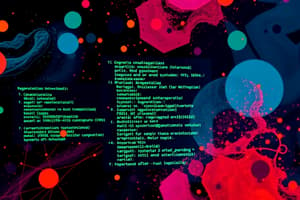Podcast
Questions and Answers
What type of user interface is NOT typically found in operating systems?
What type of user interface is NOT typically found in operating systems?
- Web-Based Interface (WBI) (correct)
- Batch Interface
- Graphics User Interface (GUI)
- Command-Line Interface (CLI)
Which service allows an operating system to load and run a program?
Which service allows an operating system to load and run a program?
- Program execution (correct)
- I/O operations
- User interface
- File-system manipulation
Which of the following is NOT a necessary function of an operating system's services?
Which of the following is NOT a necessary function of an operating system's services?
- Launching applications
- Managing I/O operations
- Performing mathematical calculations (correct)
- Handling file-system manipulation
Which of the following best describes the role of I/O operations in an operating system?
Which of the following best describes the role of I/O operations in an operating system?
What is the primary purpose of the file-system manipulation service in an operating system?
What is the primary purpose of the file-system manipulation service in an operating system?
Which of the following describes the user operating system interface?
Which of the following describes the user operating system interface?
What does the term 'system boot' refer to in operating systems?
What does the term 'system boot' refer to in operating systems?
What are system calls used for in an operating system?
What are system calls used for in an operating system?
Which component of the Android architecture is responsible for providing process, memory, and device-driver management?
Which component of the Android architecture is responsible for providing process, memory, and device-driver management?
What programming language are Android applications typically developed in?
What programming language are Android applications typically developed in?
What type of file is generated by an operating system failure that captures kernel memory?
What type of file is generated by an operating system failure that captures kernel memory?
Which specialized environment includes core libraries and allows execution of applications in Android?
Which specialized environment includes core libraries and allows execution of applications in Android?
Which of the following is NOT a feature of the iOS Cocoa Touch API?
Which of the following is NOT a feature of the iOS Cocoa Touch API?
What strategy can be used to optimize system performance beyond just fixing bugs?
What strategy can be used to optimize system performance beyond just fixing bugs?
Which library is associated with multimedia functions in Android?
Which library is associated with multimedia functions in Android?
What does Kernighan’s Law suggest about the process of debugging?
What does Kernighan’s Law suggest about the process of debugging?
Which function is NOT typically associated with system programs?
Which function is NOT typically associated with system programs?
Which of the following best defines the role of background services?
Which of the following best defines the role of background services?
What is the main distinction between mechanisms and policies in operating systems?
What is the main distinction between mechanisms and policies in operating systems?
Which type of program would be least likely to be considered a part of the operating system?
Which type of program would be least likely to be considered a part of the operating system?
Which programming language is predominantly used for the main body of modern operating systems?
Which programming language is predominantly used for the main body of modern operating systems?
What is a primary user goal in operating system design?
What is a primary user goal in operating system design?
Which of the following best describes the structure of MS-DOS?
Which of the following best describes the structure of MS-DOS?
What aspect is primarily focused on by system goals in OS design?
What aspect is primarily focused on by system goals in OS design?
What is a characteristic of UNIX in comparison to MS-DOS?
What is a characteristic of UNIX in comparison to MS-DOS?
What programming construct is primarily used at the lowest levels of operating system development?
What programming construct is primarily used at the lowest levels of operating system development?
Which of the following describes a tool used in file modification?
Which of the following describes a tool used in file modification?
Which service allows communication between processes over a network?
Which service allows communication between processes over a network?
Which of the following statements is true regarding high-level programming languages in operating systems?
Which of the following statements is true regarding high-level programming languages in operating systems?
What advantage does emulation provide for operating systems?
What advantage does emulation provide for operating systems?
Which of the following is an example of programming language support in an operating system?
Which of the following is an example of programming language support in an operating system?
Which of the following is NOT a characteristic of system programs?
Which of the following is NOT a characteristic of system programs?
What is a microkernel in the context of operating system structure?
What is a microkernel in the context of operating system structure?
System programs that provide information about the system's status may typically be used to check:
System programs that provide information about the system's status may typically be used to check:
What is the primary purpose of system calls?
What is the primary purpose of system calls?
Which API is commonly used in UNIX-like operating systems?
Which API is commonly used in UNIX-like operating systems?
What method is NOT typically used to pass parameters to the OS in a system call?
What method is NOT typically used to pass parameters to the OS in a system call?
Which type of system call does 'create file' belong to?
Which type of system call does 'create file' belong to?
In multitasking operating systems, what is the purpose of the fork() system call?
In multitasking operating systems, what is the purpose of the fork() system call?
Which of the following system calls is responsible for terminating a process?
Which of the following system calls is responsible for terminating a process?
How are device attributes generally managed in system calls?
How are device attributes generally managed in system calls?
What is the correct order of operations when a process is created in a UNIX-like system?
What is the correct order of operations when a process is created in a UNIX-like system?
What is one of the common methods of passing parameters via stack?
What is one of the common methods of passing parameters via stack?
Which of the following best describes 'protection' in the context of system calls?
Which of the following best describes 'protection' in the context of system calls?
Which statement about system calls is false?
Which statement about system calls is false?
What does the 'get process attributes' system call do?
What does the 'get process attributes' system call do?
What happens if a process exits with an error code greater than zero?
What happens if a process exits with an error code greater than zero?
Flashcards are hidden until you start studying
Study Notes
Operating System Services
- Operating systems provide services to users, process, and other systems.
- User interface: Provides a way for the user to interact with the system, using command-line, graphical user interface, or batch interfaces.
- Program execution: Operating systems load programs into memory and run them.
- I/O operations: Programs require I/O operations to interact with files or devices.
- File-system manipulation: Operating systems manage the file system, allowing users to create, delete, read, write, and manipulate files.
Operating System Structure
- There are various ways to structure an operating system.
- Simple structure, exemplified by MS-DOS, lacks modularity.
- More complex structures, like UNIX, have better separation of functions and interfaces.
- Layered approach provides abstraction, where each layer provides services to the next.
- Microkernel structure places most of the OS in user space, making the kernel smaller and more portable.
System Calls
- System calls are the interface for programs to access the operating system services.
- They are typically written in high-level languages like C or C++.
- Applications generally interact with system calls through Application Programming Interfaces (APIs), such as Win32 API, POSIX API, and Java API.
Types of System Calls
- Process Control: creation, termination, waiting, and manipulating processes.
- File Management: creation, deletion, opening, closing, reading, and writing files.
- Device Management: requesting, releasing, reading, writing, and managing devices.
- Information Maintenance: retrieving system information like time, date, and system data.
- Communications: establishing connections between processes, sending and receiving messages, and managing shared memory.
- Protection: controlling access to resources and managing permissions.
System Programs
- System programs provide a user-friendly environment for development and execution.
- Examples include file manipulation tools, status information displays, programming language support, program loading and execution tools, communication tools, background services, and application programs.
- They offer a higher-level interface to the system services compared to system calls.
Operating System Design and Implementation
- Operating system design involves defining goals, specifications, and principles.
- User goals: convenience, ease of use, reliability, safety, and speed.
- System goals: ease of design and implementation, flexibility, reliability, absence of errors, and efficiency.
- Separation of policy from mechanism: Policies specify what to do, while mechanisms define how to do it, allowing for flexibility and adaptability.
- Implementation involves using a variety of programming languages, including assembly, C, C++, scripting languages, and other specialized tools. ### iOS
- Developed by Apple
- Cocoa Touch Objective-C API for developing apps
- Media services layer for graphics, audio, and video
- Core services provide cloud computing and databases
- Core operating system based on Mac OS X kernel
Android
- Developed by Open Handset Alliance, mostly Google
- Open source
- Similar stack to iOS
- Based on the Linux kernel but modified
- Provides process, memory, and device driver management
- Adds power management
- Runtime environment includes a core set of libraries and the Dalvik virtual machine
- Apps developed in Java plus Android API
- Java class files compiled to Java bytecode then translated to executables that run in the Dalvik VM
- Libraries include frameworks for a web browser (webkit), database (SQLite), multimedia, and a smaller libc
Android Architecture
- Uses a layered architecture
- Provides a Linux kernel and a set of system services
- Applications run in a user space above the system services
Operating System Debugging
- Finding and fixing errors or bugs
- Operating systems generate log files containing error information
- Failure of an application can generate a core dump file (captures memory of the process)
- Operating system failure can generate a crash dump file (containing kernel memory)
- Beyond crashes, performance tuning can optimize the system performance
- Sometimes using trace listings of activities, recorded for analysis
- Profiling is periodic sampling of the instruction pointer looking for statistical trends
- Kernighan’s Law: "Debugging is twice as hard as writing the code in the first place. Therefore, if you write the code as cleverly as possible, you are, by definition, not smart enough to debug it."
Studying That Suits You
Use AI to generate personalized quizzes and flashcards to suit your learning preferences.




